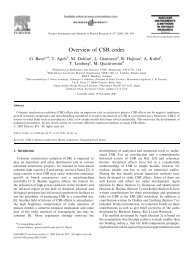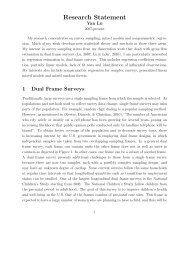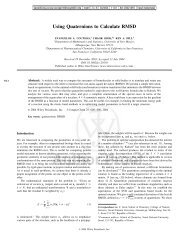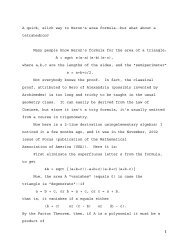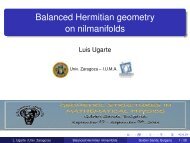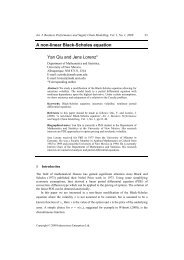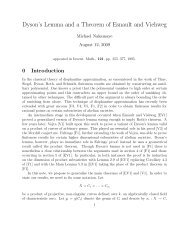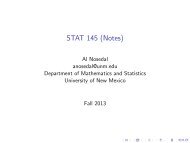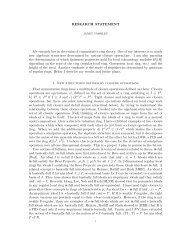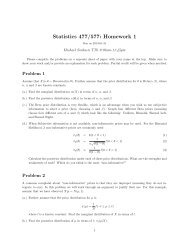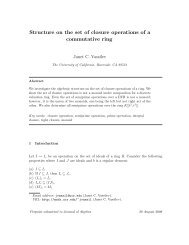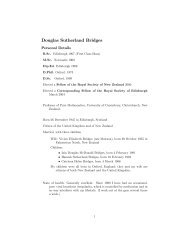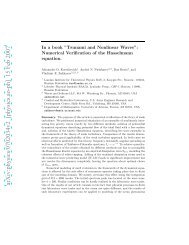OEO Office of Equal Opportunity - Department of Mathematics and ...
OEO Office of Equal Opportunity - Department of Mathematics and ...
OEO Office of Equal Opportunity - Department of Mathematics and ...
You also want an ePaper? Increase the reach of your titles
YUMPU automatically turns print PDFs into web optimized ePapers that Google loves.
HISTORY 227<br />
573./373. The Mexican Revolution. (3) Hall<br />
Study <strong>of</strong> the events, leadership, social <strong>and</strong> economic implications,<br />
<strong>and</strong> role <strong>of</strong> U.S. involvement in the Mexican Revolution<br />
<strong>of</strong> 1910–1920.<br />
574./374. Southern South America. (3) Hutchison<br />
Argentina, Chile, Uruguay <strong>and</strong> Paraguay from colonization to<br />
the present. Most emphasis on late 19th <strong>and</strong> 20th centuries,<br />
when these nations led the region’s development. Deals with<br />
the rise <strong>of</strong> the export economies, populist movements, militarism<br />
<strong>and</strong> socio-economic stagnation.<br />
575./375. Rebellion <strong>and</strong> Revolution in Modern Andean<br />
Nations. (3) Gauderman<br />
Focuses on the history <strong>of</strong> Bolivia, Colombia, Ecuador <strong>and</strong> Peru<br />
from their independence from Spain to modern times. Explores<br />
political <strong>and</strong> economic themes as well as the socio-economic<br />
<strong>and</strong> political dimensions <strong>of</strong> class, race, ethnicity <strong>and</strong> gender.<br />
576./376. Brazil in the Colonial Period, 1500–1822. (3)<br />
Bieber<br />
Colonial Brazil from 1500 to 1822. Focus on structures <strong>of</strong> colonialism<br />
<strong>and</strong> their impact on indigenous, African <strong>and</strong> European<br />
peoples. Plantation society, slavery, mercantile policy, the role<br />
<strong>of</strong> the church, women <strong>and</strong> family will be discussed.<br />
577./377. Modern Brazil, 1822–Present. (3) Bieber<br />
History <strong>of</strong> Brazil since independence. Topics include oligarchical<br />
politics, the end <strong>of</strong> slavery, race relations, urbanization,<br />
industrialization, authoritarian regimes, labor <strong>and</strong> peasant<br />
movements.<br />
580./380. The Ancient Near East. (3)<br />
A political <strong>and</strong> social survey <strong>of</strong> civilization in Egypt <strong>and</strong><br />
Mesopotamia from its birth in Sumer in the fourth millennium<br />
to the destruction <strong>of</strong> the Achaemenid Persian empire<br />
by Alex<strong>and</strong>er.<br />
581./381. Traditional China. (3) Porter<br />
Emergence <strong>and</strong> development <strong>of</strong> Chinese civilization to its<br />
height in the 13th century, including cultural, political, social<br />
<strong>and</strong> economic themes.<br />
582./382. Imperial China. (3) Porter<br />
The development <strong>of</strong> early modern society <strong>and</strong> the impact <strong>of</strong><br />
the West from the 13th to the 20th century.<br />
583./383. Revolutionary China. (3) Porter<br />
Political, social economic <strong>and</strong> cultural history <strong>of</strong> China in the<br />
revolutionary period from 1911 to the present.<br />
584./384. History <strong>of</strong> Japan. (3) Porter<br />
Social, political, <strong>and</strong> economic institutions from historical<br />
beginnings to modern times.<br />
586./386. The Islamic Middle East to 1800. (3) Risso<br />
The political, social <strong>and</strong> economic development <strong>of</strong> the Islamic<br />
world through the Ottoman <strong>and</strong> Safavid eras. Arab, Persian<br />
<strong>and</strong> Turkish elements <strong>of</strong> Islamic civilization will be included.<br />
587./387. The Modern Middle East from 1800. (3) Risso<br />
Topics include 19th-century reform attempts, the transition<br />
from empire to nation-states, the gap between ideology <strong>and</strong><br />
practice, the Arab-Israeli conflict <strong>and</strong> revolutionary Iran.<br />
597./497. Introduction to Editing Historical Journals.<br />
(3) Ball<br />
Nature <strong>and</strong> problems <strong>of</strong> editing historical journals. Appraisal,<br />
evaluation, revision <strong>and</strong> preparation for publication, including<br />
practical experience.<br />
601./401. Anglo-Saxon Engl<strong>and</strong>, 450–1066. (3) Graham<br />
This course will <strong>of</strong>fer an overview <strong>of</strong> the history <strong>and</strong> culture <strong>of</strong><br />
Engl<strong>and</strong> from the arrival <strong>of</strong> the Angles <strong>and</strong> Saxons in the middle<br />
<strong>of</strong> the fifth century until the Battle <strong>of</strong> Hastings <strong>of</strong> 1066.<br />
602./402. The Crusades. (3) Rubenstein<br />
This course will examine the phenomenon <strong>of</strong> the Crusades in<br />
the Middle Ages, examining the three (arguably more) distinct<br />
cultures involved <strong>and</strong> addressing issues relevant to social,<br />
political, intellectual <strong>and</strong> military history.<br />
611./411. History <strong>of</strong> Engl<strong>and</strong>, 1066–1660. (3) Rubenstein<br />
Survey <strong>of</strong> medieval foundations, Tudor era <strong>and</strong> 17th-century<br />
social <strong>and</strong> political revolutions.<br />
612./444. Native American <strong>and</strong> Celtic History Since<br />
1700. (3) Connell-Szasz<br />
Course will have a cross-cultural focus <strong>and</strong> look at how<br />
major trends <strong>of</strong> the modern era have played out among<br />
various American Indian/Alaska Native Nations <strong>and</strong> the Celtic<br />
people <strong>of</strong> Eire (Irel<strong>and</strong>), Alba (Scotl<strong>and</strong>) <strong>and</strong> Cymru (Wales).<br />
614./414. Twentieth Century Spanish Culture. (3) Sanabria<br />
An historical approach to Spanish culture since the Spanish/<br />
American War (1898), focusing on regionalism, the commercialization<br />
<strong>of</strong> sport <strong>and</strong> leisure, the construction <strong>of</strong> gender<br />
roles <strong>and</strong> Spain’s entry into the European Community.<br />
615./415. European Diplomatic History. (3) Spidle<br />
Since 1815.<br />
616./416. History <strong>of</strong> Medicine to 1850. (3) Spidle<br />
A survey <strong>of</strong> western medicine’s development to mid-19th<br />
century, aimed at the nonspecialist. Includes the impact <strong>of</strong><br />
health factors in general historical development.<br />
617./417. History <strong>of</strong> Modern Medicine. (3) Spidle<br />
Survey <strong>of</strong> western medicine since mid-19th century, aimed<br />
at the nonspecialist. Includes the impact <strong>of</strong> health factors in<br />
general historical development.<br />
618./418. City Life. (3)<br />
A study <strong>of</strong> the development <strong>of</strong> urban spaces <strong>and</strong> urban lives<br />
from the 17th century, which considers the impact <strong>of</strong> political<br />
<strong>and</strong> cultural changes upon physical spaces <strong>and</strong> their impact<br />
upon modern lives.<br />
619./419. Formation <strong>of</strong> Modern European Culture. (3)<br />
Via a broad variety <strong>of</strong> media arts, theories <strong>and</strong> documents,<br />
this course introduces students to people <strong>and</strong> events that<br />
have contributed to changing definitions <strong>of</strong> modern European<br />
cultural identity between the 17th <strong>and</strong> 20th centuries.<br />
620./420. Modern France since 1815. (3) Sanabria<br />
A survey <strong>of</strong> French history from the Bourbon Restoration<br />
through modern times. Particular attention given to the Third<br />
Republic, the French colonial empire, French fascism <strong>and</strong><br />
Vichy France, <strong>and</strong> France’s role in the modern world.<br />
ARTS AND<br />
SCIENCES<br />
588./388. India. (3) Risso<br />
History <strong>of</strong> South Asia with emphasis on cultural development,<br />
social groups <strong>and</strong> religious communities <strong>and</strong> the establishment<br />
<strong>of</strong> the modern nation-state <strong>of</strong> India.<br />
590./490. World History: Comparative Themes. (3)<br />
Skipping through time <strong>and</strong> space, this course investigates a<br />
series <strong>of</strong> themes common to human existence, <strong>and</strong> stresses<br />
interaction among different societies <strong>and</strong> civilizations. Team<br />
taught by three members <strong>of</strong> the History <strong>Department</strong>.<br />
595./495. Introduction to Public History. (3) Ball<br />
The object <strong>of</strong> this class is to introduce students to the field <strong>of</strong><br />
Public History. The course will embrace the theory, method<br />
<strong>and</strong> practice <strong>of</strong> public history.<br />
621./421. Britain 1660 to the Present. (3)<br />
Surveys British society <strong>and</strong> culture from the restoration to<br />
the monarchy <strong>and</strong> emphasizes Britain’s influence on world<br />
politics <strong>and</strong> culture.<br />
622./422. Modern European Imperialism. (3)<br />
This course examines the expansion <strong>of</strong> European imperialism<br />
since the 17th century, from trading companies to cultural<br />
imperialism.<br />
623./423. Germany, 1871 to 1971. (3) Spidle<br />
Bismarck to Br<strong>and</strong>t, a survey <strong>of</strong> German history from unification<br />
to contemporary times, with special emphasis on Weimar<br />
<strong>and</strong> Hitlerian Germany.<br />
UNM CATALOG 2006–2007 Symbols, page 611.



